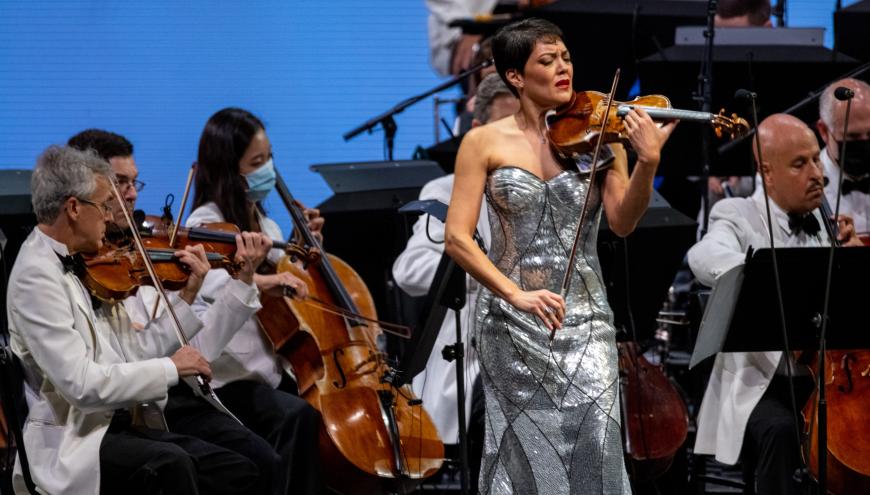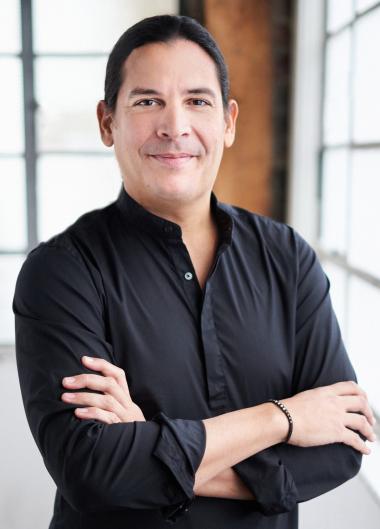
Symphony San José’s concert on May 6 at the California Theatre featured Anne Akiko Meyers as soloist in Mexican composer Arturo Márquez’s new violin concerto, Fandango. Meyers requested the work from Márquez and gave the first performance, with Gustavo Dudamel and the Los Angeles Philharmonic, in August 2021. Since then, she has been taking the piece around on her guest appearances.
So it’s fortunate that when San José’s intended guest conductor, Tatsuya Shimono, withdrew for personal reasons less than two weeks before the concert, the Symphony was able to secure José Luis Gómez, music director of the Tucson Symphony, as a replacement. He had conducted Meyers in this same concerto in a Tucson program last September.
Meyers had been inspired to approach Márquez after hearing the composer’s Danzón No. 2, a boundlessly joyful expression of the character of Veracruz’s dance music that’s become something of a signature piece for Dudamel. Meyers hoped that Márquez could import something of the same spirit into a violin concerto. It turned out that the composer, whose father was a mariachi violinist, had already been thinking along those lines.

The resulting piece has three movements, each based on a dance rhythm. Gómez outlined this in a preconcert talk. The first two, the lively folia and the slow and sultry chacona, are old Spanish dances here subjected to Mexican and Caribbean influences; the third, the urgently spinning huapango, is a native Mexican mariachi style. In each movement, the rhythm is set up — the first two by the orchestra, the third by the violinist after a solo cadenza — and then a lively game is on. Meyers’s busy and energetic but not exhausting solo part takes over and enforces the rhythm, often with precise and glistening spiccato notes, then plays off of it in decorative passages while the orchestra keeps the engine going. The music then detours into quieter episodes, for in neither this concerto nor the Danzón No. 2 are the rhythms incessant or implacable. This is a dance into joy, not exhaustion.
Meyers played with great smoothness and ease for such a precision-oriented display work. Her tone was full-bodied and stayed consistent as her bow switched direction. An air of firm determination suffused her performance. The orchestra, in a generally brilliant work, exuded color. Principal clarinet Michael Corner had a particularly notable and elegant solo in the first movement.
The music, while not as catchy as the Danzón No. 2, is full of the same energy, color, and variety. Interestingly, the finale sounds less like the renowned Huapango by José Pablo Moncayo than like Aram Khachaturian’s Violin Concerto in its figurations and Philip Glass’s Violin Concerto No. 1 in its harmonic progressions.
The other major piece on the program was the Symphony No. 4 in E Minor, Op. 98, by Johannes Brahms. A slow, dreamy work in some readings, this rendition avoided anticlimax after the dramatic, energetic, and cogently compact Fandango. The most distinctive quality of this performance was the tone color. Gómez achieved a balance between Brahms’s characteristically blended sound and conspicuous solos. The timbre of two or three instruments playing together, succeeded by another set of instruments and then another, provided a subtle series of shadings that kept the music colorful even without bright flashiness.
The concert was topped with the brief Prelude in F Minor for Strings, Op. 25, by the British composer Gerald Finzi. This is a dark-toned, contemplative, and pastoral piece in a vein similar to works by other British composers of the early 20th century. All the string sections of the orchestra conveyed the music with sober grace.



